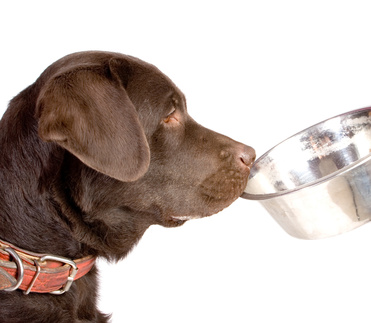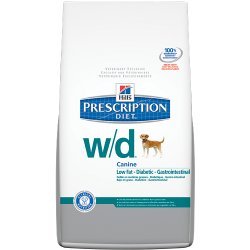The Best Diabetic Dog Food Options
With the growing incidence of diabetes it is important to know which
diabetic dog food is best for your pet. The goal is to maintain normal sugar levels and therefore control any symptoms that could lead to additional diabetes mellitus complications. Managing the diet, in addition to insulin, is an essential part of disease management.
Owners need to change the diet of their dogs if they have diabetes in order to properly manage the disease and prevent serious complications. Since insulin is the primary way diabetes mellitus is treated, the choice of diet should be made in consultation with your vet since it needs to enhance insulin effectiveness. Once a diet is selected, do not give your dog any other food including dog treats or table scraps.
Diabetic Dog Food should be dry, not semi-dry or canned. Dry dog foods contain complex carbohydrates which are harder to digest, reducing the chance of rapid increases in blood sugar levels.
Shown: Hills W/D Diabetic Dog Food
Diet becomes a great aspect in a dog's lifestyle once they develop diabetes. Your responsibility as an owner is to treat your dog's condition with medication and to give them the exercise that they need.
Most importantly, since you are the one who is in great control of what your dog takes in during the course of the disease, then you must be very knowledgeable on what and what not to give your dogs.
When planning the best food to give your dog, your aim must be to maintain the blood sugar at normal levels, achieve and maintain desirable weight and to prevent further complications brought about by high blood sugar levels.

Choosing the Right Diabetic Dog Food
Choosing the right food for your dog can be a daunting task most especially if your dog has just been diagnosed with diabetes.
Here is a quick guide:
- Food Components: The dog food should contain less
sodium, sugar, and carbohydrates. Go for dry canned food since moist
and soft dog foods are noted to have higher carbohydrate contents. Also, dry dog food contain digestible complex carbs which slows the digestive process, minimizing fluctuation in blood glucose levels. DO NOT feed semi-moist foods since the carbohydrates in these diets are more easily digested, possibly raising sugar levels (hyperglyceamia).
Make sure that you read the levels first before buying. If there is no label or nutritional facts, you had better avoid that food. In general, veterinary nutritionists tend to avoid reduced fat or carbohydrate foods since this may harm the overall condition of the dog.
Fiber: Foods with higher levels of fiber are beneficial for dogs that are overweight. The fiber improves sugar control by delaying the digestion of starch and sugar absorption into the blood. Higher levels of fiber also help with dog weight loss. The downside of higher fiber dog diest is that they don't taste as good and the lower levels of calories can cause excessive weight gain in dogs that are already at normal weight. In general, higher fiber levels are only for overweight dogs. - Overweight Dogs: If your dog is overweight, look for foods that are low in fats and calories. Overweight dogs are more prone to develop diabetes. If they already have diabetes, managing the weight is one of the best ways to alleviate the disease. Good choices for diabetic dogs that are overweight are Purina OM or Hill's Prescription Diet w/d or r/d. Discuss these options with your veterinarian.
- Dog Feeding Schedule: The time of day that you feed a diabetic dog food should enhance insulin effectiveness. Food should be eaten when the insulin is still present in the blood and therefore can handle the higher levels of glucose entering the body.
- Feed Several Small Meals: Diabetic dog food should be provided in several smaller meals instead of one large meal. In general, a diabetic dog would do better if fed two equal sized meals after insulin is injected. If a dog isn't stabilized on this diet, then move to 3 to 4 equal sized meals.
- Consider a Pet Shop: Buying the specialist diabetic dog food available in pet shops is a good idea since you can be sure that the food is formulated especially for dogs with diabetes. But actually, you can also feed them with homemade food provided that you consult your vet first.
- See a Vet: Before your vet will tell you about the nutritional level and ingredients needed for your dog, they will first confirm the severity of the case to make sure the diet fits your dog.
- Natural Supplements: There are natural remedies available that are formulated to help maintain normal insulin and sugar levels. If you would like to support your dog with an approach designed to improve body function, discuss GlucoEnsure with your Veterinarian.
A diabetic dog food will have antioxidants that are needed to fight toxins and free radicals and are already complete with the nutrients that dogs need.
Measuring Dog Dietary Response
Dogs taking insulin should be monitored for blood glucose
concentrations. One level is taken before giving the dog insulin and one
before the 2nd dog feeding. Measuring the amount of water a dog drinks
also helps the Veterinarian understand how to achieve diabetic control.
Dog blood proteins should be measured to determine how a dog is responding to treatment. Dogs that are doing well will have a glycosylated haemoglobin level of between 4% and 6%.
If your dog is suffering from diabetes, it is not just a case of managing their medications but you also need to manage their lifestyle and diet. Keep records! Just like humans, these dogs need a proper diet and monitoring to manage the condition.
Related Articles:
Diabetic Dog Food And Dog Diabetes Overview
Labrador Retriever Health
Cancer Treatment And Care For Dogs
References:
Dog Health Handbook - Diabetic Dog Diet
New Strategies in the Management of Canine Diabetes Mellitus
Michael E Herrtage MA BVSc DVSC DVR DVD DSAM DECVIM DECVDI MRCVS
Department of Veterinary Medicine,
University of Cambridge
